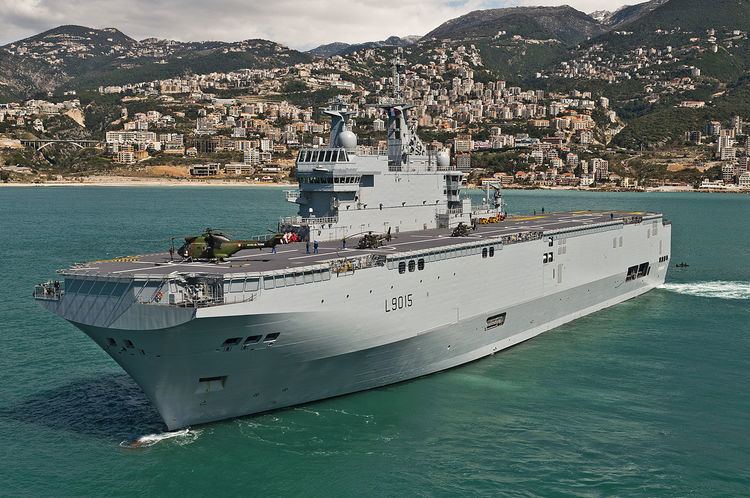 | ||
Indian Navy The Indian Navy has stated a need for 4 MRSV's. DCNS/ARMARIS (21,300 tons) Mistral LHD Fincantieri (20,000 tons) Multi-functional Ship [LHD] Navantia (27,079 tons) Juan Carlos I LHD Hanjin Heavy Industries BAE Systems (21,578 tons) Ocean Class LHD | ||
India's Ministry of Defence finalised a project for the procurement of four Landing Helicopter Docks (also referred to as "Multi-Role Support Vessel") in order to upgrade the Indian Navy's disaster response, amphibious warfare and island protection capabilities. The project is worth ₹16,000 crore (US$ 2.6 billion), and tenders were issued in December 2013 to three domestic shipyards.
Contents
History
As a precautionary measure against People's Republic of China's naval presence in the Indian ocean, acquiring amphibious warfare ships and aircraft carriers has become a top priority for Indian Navy. Consequently, Andaman and Nicobar Command (ANC) is being developed into a major Amphibious Warfare Hub for Indian Navy and it is considered crucial to counter China's strategic moves in the Indian Ocean as well as ensure security of these sea lanes.
In 2011, it was reported that India is looking for up to four LHD type aviation and amphibious ships, with designs to come from foreign firms. In November 2013, the Defence Ministry has issued a tender for building warships which can carry helicopters. The tender was issued as part of efforts by the government to build the capabilities of the indigenous industry.
Criteria for selection
Although moderately flexible, the basic criteria are:
- Size: Should be no more than 215 metres long; and draught at full load must not exceed 8 metres.
- Aviation facilities: Aviation deck to carry 10 heavy helicopters, up to 35 tons.
- Troop space: Accommodate 1,430 personnel, including 60 officers, 470 sailors and 900 troops.
- Load carrying capability: Combination of landing craft, including landing craft mechanised to ferry tanks; landing craft, vehicle, personnel to transport troops; and the fast-moving landing craft air cushion vessels. Should carry six main battle tanks, 20 infantry combat vehicles and 40 heavy trucks.
- On-board weapons: Point-defence missile system, close-in weapon system, an anti-torpedo decoy system, a chaff system, and heavy and light machine guns.
- Range and endurance: Endurance of 45 days, with a maximum sustained speed of not less than 20 knots.
- Propulsion: Powered by electric propulsion systems.
- Special Features: Specialised areas from hospital facilities to naval command centre.
- Role: Conducting maritime surveillance, special operations, search and rescue, medical support and humanitarian aid.
Mistral LHD (DCNS, France)
DCNS/Armaris's contender is a modified version of the Mistral Class ship. The ships in this class are generally able to carry around 900 armed troops and 16 heavy or 35 light helicopters. France's DCNS is currently India’s shipbuilding partner for its new Scorpene class diesel electric fast attack submarines. The Mistral meets every criterion for the MRSV project.
Multi-functional Ship LHD (Fincantieri, Italy)
The Indian Navy recently received the first Deepak class fleet tanker by Italy’s Fincantieri which is currently working with India to build the Vikrant class aircraft carrier. Although Fincantieri has a history of naval industrial relations with India, it is yet to fully develop a ship that fits the criteria for Multi-Role Support Vessel. However, according to their website, Fincantieri is fully capable of manufacturing a vessel which they list as a 20,000 tonne "Multi-functional ship". This ship is purported to be suitable for the "MRSV" title.
Juan Carlos I Class (Navantia, Spain)
Navantia built the Juan Carlos I LHD for the Spanish Navy, and is building two similar ships for the Australian Navy. It is also a strong contender for the title of "Multi-Role Support Vessel" as it meets each criterion perfectly. With its ski jump for STOVL operations, it is conceptually similar to a Wasp Class LHD. Nonetheless, if India would be willing to compromise with a smaller vessel or LPD, then this would expand Navantia's scope by including the Galicia Class LPD, which was co-developed with Royal Schelde.
Construction
The Indian Navy issued a ₹16,000 crore (160 Billion INR - US$ 2.6 billion) domestic tender to three domestic shipyards - Larsen & Toubro (L&T) which has tied up with Navantia of Spain, Pipavav Defence and Offshore Engineering which has partnered with France’s DCNS, and ABG Shipyard which has partnered with USA's Alion. After the winning design is selected, the private shipyard will construct two LPDs and the remaining two will be constructed by state-owned Hindustan Shipyard Ltd (HSL).
